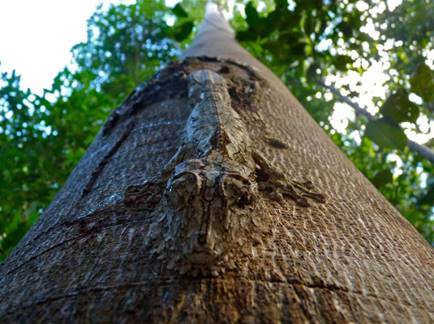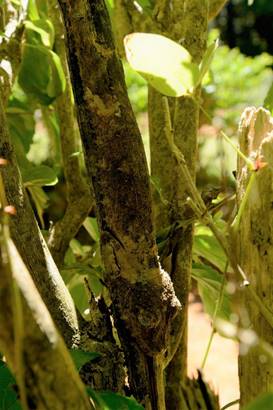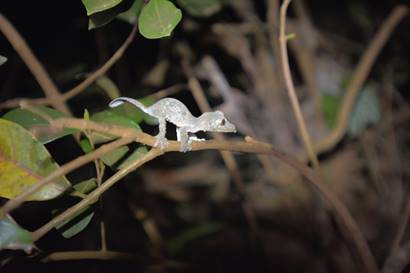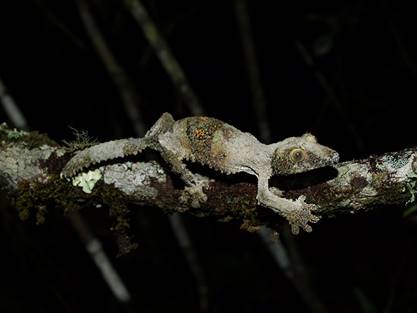Naked is the best disguise. Jeanette Winterson
The Uroplatus genus contains 14 species that are endemic to Madagascar. As with many genera on Madagascar – it represents a stunning range of ecological expansion and biodiversity. Having been isolated from mainland Africa for over 60 million years, speciation has had time to peg the meter in Madagascar. This species inhabits both primary (old growth) and secondary tropical forests in the eastern and central parts of the island. This is a large gecko measuring 6 – 8 inches with large lidless eyes with elliptical pupils. The eyes have a yellow sclera – what in humans is the white of the eye.
Geckos of the Uroplatus genus have a tail dorso-ventrally flattened, which reduces their visible profile when they sit still on tree limbs. The mossy-tailed gecko has a unique color that provides camouflage – most of the body is a grayish brown to black or greenish brown with scattered markings that strongly resemble tree bark and its lichen patterns. This gecko also has irregular flaps of skin that run the length of its body, head, and limbs. Short Video

his species lays flat against tree stems or limbs during the day, head down with front legs forward and back legs pointed backward. Its shadow is broken up by the irregular skin texture and its unique coloration, making it quite difficult to find. It has the ability to alter its skin color to match the color of its perch. Locally it is known as the King of Camouflage.
This species is nocturnal and arboreal, spending the day resting in place. At night they will venture out from their resting spots to search for prey, which includes a number of insects, arthropods, and gastropods. It is generally found in mid-elevation forests within 3-15 feet from the ground. It apparently does not tolerate highly degraded forests.
The destruction of forest habitat is the primary threat to the species survival, but collection for the pet trade also is a serious concern. The World Wide Fund for Nature (formerly the World Wildlife Fund) lists all Uroplatus species on their Top Ten Most Wanted Species List of animals threatened by illegal wildlife trade because they are “being captured and sold at alarming rates for the international pet trade”.
Uroplatus – Latinization of two Greek words – oura, meaning tail, and plats, meaning flat. The species name honors Franz Sikora, an Austrian fossil-hunter and explorer of Madagascar. The species was originally described by the German zoologist Oskar Boettger but not published until three years after his death. Boettger suffered from agoraphobia and rarely left home – relying on assistants to bring him specimens for his work.
In contrast, Sikora was a whirling dervish of field energy, scouring Madagascar for fossils and whatever natural history items he bumped into. He is particularly known for the amazing finds at Andrahomana, a cave in southern Madagascar that yielded many fossils including that of an extinct giant lemur.
I recently spent a month in Madagascar, which provided quite the treasure chest for OOTW postings, and visited Montagne d’Ambre park in the NE part of the island. In all Madagascar Parks you are required to have a local guide, which serves several purposes. It provides income for the knowledgeable locals, it keeps visitors from wandering where they should not go, keeps you from getting lost, and provides a guide who can find the animals for you. I can’t emphasize the last item too much.
As a wildlife biologist with 35 years’ experience I think of myself as rather observant and able to find animals quickly. As in visits to other countries, I was quite humbled by my lack of field sense of the complex vegetation types and difficulty in finding animals. The local guides were so fast at finding birds, mammals, amphibians, or reptiles it was stunning. At Montage d’Ambre we met our local guide, Nichole, all 5 ft. of her, the evening before we were going hiking in the park.
Asking what we wanted to see I noted the elusive mossy leaf-tailed gecko and she said we could try during the day, but our later night walk might be more fruitful because they are so well camouflaged and don’t move much during the day. When I mentioned I was a wildlife biologist she said “Great – you can be my assistant in finding animals”. Yea, we’ll see.
We were walking around the rain forest the next day and Nichole was telling us about the natural history of a species of chameleon she recently pointed out and then, with just a sideways glance, she stopped, turned towards me and smiled and said with a rising sing-song voice of anticipation “A Uro-platus!”.
She leaned towards the shrub next to her and drew 3-foot sided square in the air and said – “In this box is a mossy leaf-tailed gecko” and then gestured to me to find it. I stood there, my face 6 inches from the shrub with my nose in the middle of the box. Oh come on! I’m a wildlife biologist with a passion for reptiles –where is this dang thing? Nothing. After literally 5 minutes I surrendered as Nichole stood by stifling her giggles.

She leaned forward and pointed, almost touching the gecko. It took another 5 seconds of me staring and then, POP! There he was. The King of Camouflage indeed. Nichole would play this game with me over and over, with a variety of secretive reptiles, with similar results.

